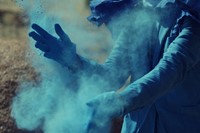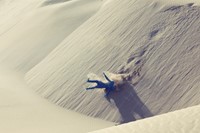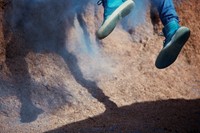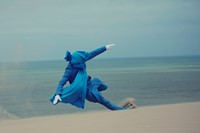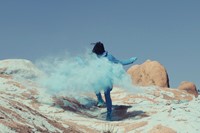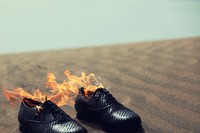Frode & Marcus’s Apocalypse opens today at Parsons Paris School of Art + Design, presenting the results of a four-year collaboration between Swedish fashion photographer Marcus Palmqvist and Norwegian artist Frode Fjerdingstad. On view will be a

Frode & Marcus’s Apocalypse opens today at Parsons Paris School of Art + Design, presenting the results of a four-year collaboration between Swedish fashion photographer Marcus Palmqvist and Norwegian artist Frode Fjerdingstad. On view will be a selection of their recent films, including the lovely La Vitesse Et La Pierre – shot in the Sahara desert and first displayed in Paris as part of the A Shaded View on Fashion Film festival in 2009 – and Legalement Aveugle, a film for Maison Martin Margiela shown at the Centre Pompidou earlier this year. The pair often feature themselves as the main characters in their work (usually disguised by using wigs and paint, or smoke and handstands), and rely on surrealistic narratives rather than the sleek imagery that so often populates today’s fashion films. AnOther caught up with Frode & Marcus on the eve of their opening to listen to their tales of adventure and misadventure in the making of their elegant – and often bizarre – fashion films.
Tell me about the work you're showing here in Paris.
Marcus: There are images from all of our main projects, which always deal with themes of alienation and fragmented identities. We focus on characters who find it difficult to fit into society. They have often lost control of gravity and float around with their own chaotic internal logic. For instance, Lait, Une Couleur deals with a split personality…and milk. When we shot it in London, people were very provoked by the main character’s white makeup and long black wig. One man thought he was Michael Jackson, and some other guys wanted to beat him up.
Give me some of the background about the films in the show.
Marcus: We drove 3,000 km across West Africa to shoot La Vitesse Et La Pierre, a collaboration we made with director Igor Zimmermann. We slept in the trunk of the car outside of deserted towns, set a shoe collection on fire in the desert, and had long discussions with African border police about whether photography can be art (mostly to explain why we had 30 kilo of blue dye in our luggage).
Frode: Marcus and Igor ate fish in a road shack called Café de Paris and ended up getting sick in the desert while dressed up as nomads covered in blue paint.
Marcus: …but that was nothing compared to the rotten sheep corpse we found in the old barn where we shot Beekeeper. I grabbed it thinking it was a branch and accidentally threw dead sheep all over the set.
It sounds like your shoots are adventures unto themselves. Tell me more…
Marcus: In the attic of the barn where we shot Beekeeper, we found a tent, a line with old clothes hanging on it, a little stove, a table with a vase, and frying pan. It seemed like someone had been living there for a long time. Everything was covered with a thick layer of dust. It seemed like whoever lived there had left in a hurry, and then time just stood still for years and years.
Frode: We shot parts of Legalement Aveugle in the south of France. There were three of us sleeping in the car, and a drunk came up and started to sexually harass us.
Marcus: …probably because we were sleeping in Margiela sequined pants.
Marcus, you’re from Sweden and mostly work with fashion photography. Frode is from Norway. Where did you meet and how did your collaboration come about?
Frode: We met in college in London. One night over pints in a pub, we realized that we had similarly fucked up ideas. It still took a few years before we started working as a duo. That was around 2006.
Marcus: Yes, we were supposed to do a project in Switzerland about pig farming, but we ended up doing our first Frode & Marcus project in Paris instead. The big difference between collaborating and working individually is how we bounce ideas off one another. Sometimes we don’t stop until we’re both cracking up laughing because we’ve managed to hit upon the most surprising or weird solution possible. When we work individually, we work in more traditional ways as photographers and filmmakers. As a duo we allow ourselves to be banal, grand and genius at the same time.
What are your plans for the near future?
Marcus: We’re preparing a film series called Struntkillen for an exhibition in New York in March.
Frode: Struntkillen is based on local townies in Sweden and Norway that we knew when we were kids. He will be an anti-social local pinball machine addict, chain-smoking rolled cigarettes and making funny sounds. We’re also going to make a film in the deserted landscapes of Svalbard [in the Arctic north of Norway] in spring 2011. It will be more of a weird expedition than a traditional shoot. Oh, and a book called Beekeeper and a music video, too.
Text by Julie Cirelli
Apocalypse is on view at Parsons Paris School of Art + Design from now till 15 January, 2011
Julie Cirelli is a writer and editor from New York, now based in Paris. She regularly contributes to V Magazine, Dossier Journal and S Magazine, among others

